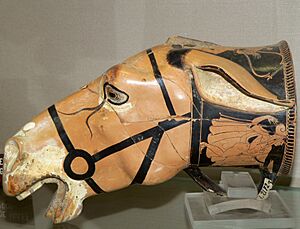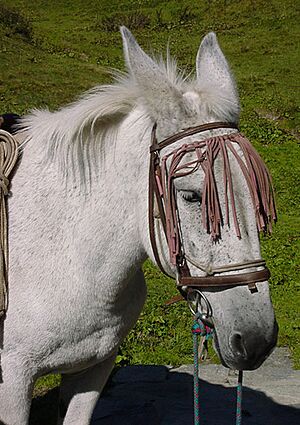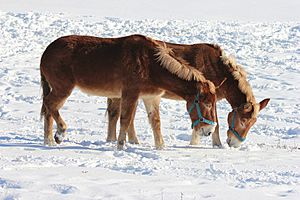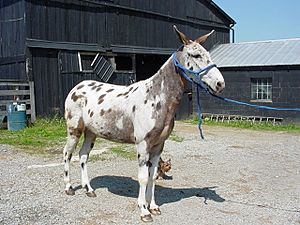Mule facts for kids
A mule is a special animal that's a mix of two different animals: a horse and a donkey. It's born when a female horse and a male donkey have a baby together.
Mules are mostly used for pulling carts and carrying things. It's very rare for a mule to have babies, but it can happen! Mules are usually careful, which sometimes makes people think they are stubborn. They like to know exactly where they are walking or what they are about to cross. They can get scared by anything that looks unusual. Mules also compete in shows against horses or other mules. They are great for both western and English riding, and they can even jump very high!
Contents
What Makes a Mule Special?

Mules have a mix of features from both their parents. From their donkey father, they get a short, thick head, long ears, thin legs, small hooves, and a short mane. From their horse mother, they get their height, body shape, neck, and rump, as well as their teeth and a uniform coat color.
Mules come in all sizes and shapes! Some mules look like huge farm horses, while others look like strong quarter horses, speedy racehorses, or even shaggy ponies.
Mules are a great example of something called hybrid vigor. This means that a hybrid animal (like a mule) can sometimes be stronger, smarter, and live longer than either of its parents. The famous scientist Charles Darwin once said that mules seem to have more reason, memory, stubbornness, affection, endurance, and a longer life than horses or donkeys.
Mules get many good traits from their donkey father, like intelligence, being sure-footed (good at walking on tricky ground), toughness, endurance, a good attitude, and natural carefulness. From their horse mother, they get speed, a good body shape, and agility (being quick and nimble). Mules are thought to be smarter than both horses and donkeys, but scientists are still studying this. Mules are usually taller than donkeys and can last longer than horses, even though horses can run faster.
People who work with animals often prefer mules over horses. Mules are more patient when carrying heavy loads, and their skin is tougher and less sensitive to sun and rain. Their hooves are also harder than horses' hooves, and they are naturally good at resisting diseases and insects. Farmers with clay soil often found mules to be better at pulling plows than horses.
A mule's sound is unique! It's not exactly like a donkey's bray or a horse's whinny. A mule's sound often starts like a horse's whinny but ends with a donkey's "hee-haw." Sometimes, mules also whimper.
Colors and Sizes of Mules
Mules come in a huge variety of shapes, sizes, and colors. Some are tiny, weighing less than 50 lb (23 kg), while others are very large, weighing over 1,000 lb (454 kg)!
Their coats come in the same colors as horses. The most common colors are sorrel (a reddish-brown), bay (brown with black mane and tail), black, and grey. You might also see less common colors like white, roans (mixed white and colored hairs), palomino (golden with a white mane and tail), dun (a sandy yellow-brown), and buckskin (a tan color with black points). The rarest colors are paint mules or tobianos (mules with large patches of white and another color).
If an Appaloosa mare (a horse breed known for its spotted coat) is the mother, the mule will often have wild and unique spotted patterns, even more so than Appaloosa horses!
Mules in Modern Times
In the second half of the 1900s, fewer mules were used in countries with a lot of factories and machines. This is because machines like tractors and trucks took over much of the work that mules used to do for farming and transportation.
However, in the United States, some people continued to breed mules as a hobby. They used better mares (female horses) to create modern saddle mules, which are great for riding. Today, mules compete in many horse shows, including Western and English pleasure riding, as well as dressage and show jumping competitions. Mules, once not allowed in traditional horse shows, are now accepted at the most famous horse shows in the world!
Mules are still very important for carrying cargo in rough areas where there are no roads. For example, they are used in the large wilderness areas of California's Sierra Nevada mountains. Commercial pack mules help supply camps for mountaineers, and also carry tools and materials for building and fixing trails and bridges in remote areas.
Amish farmers, who choose not to use modern technology for religious reasons, often use teams of six or eight mules to pull plows and other farm equipment. They use horses for pulling buggies on the road.
Mules have also been used by armies. During the Soviet–Afghan War, the United States used many mules to carry weapons and supplies over Afghanistan's rugged mountains. U.S. forces continued to use mules during the War in Afghanistan. The United States Marine Corps even has a special training course for handling animals in the mountains.
Mule Trains
A mule train is a line of pack mules, usually carrying cargo. Mules are great for this because they can carry at least as much as a horse, are very sure-footed on difficult paths, and can eat poorer, coarser foods. They can also handle dry areas well. Because of these traits, mule trains were a common way to transport large amounts of goods using animal power, even in ancient times.
In many situations, a group of pack horses would need to carry more food for themselves, like oats, which means they could carry less cargo. Mules, on the other hand, can survive on rough plants, small shrubs, and even some tree leaves. Horses and cattle mostly need grasses, which are found in different climates.
Mule trains were very important in opening up the American West. These sure-footed animals could carry up to 250 pounds (110 kg) and survive on the natural plants they found. In modern times, groups of sure-footed mules are used to carry riders in beautiful but dangerous backcountry areas, like trips into canyons.
Images for kids
-
A 20-mule team in Death Valley, California.
-
The Devil's Bridge at Schöllenen Gorge, a drawing by Peter Birmann.
-
A mule train crossing the Quesnel River in 1868.
-
A mule train in British Columbia in 1911.
-
Mule cars in Celaya, Guanajuato, Mexico, in the 1930s.
-
Ploughing with a mule in Saluda, South Carolina, in 1947.
-
Mules delivering mail in Supai, Arizona, in 2008.
-
On the South Kaibab trail in the Grand Canyon.
See also
 In Spanish: Mula (animal) para niños
In Spanish: Mula (animal) para niños

















